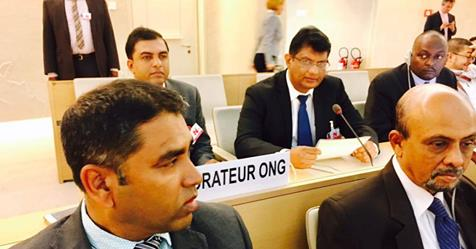In Light Of Dr Nalaka Godahewa’s Speech At The UNHRC In Geneva – Part III

By Lionel Bopage –20November 2017
 [Part 2 of this series was published on Thursday, the 16th November 2017]
[Part 2 of this series was published on Thursday, the 16th November 2017]
Points Dr Godahewa has raised
 Post-independence Sri Lanka offered equal rights to all citizens and communities; no minority is discriminated by any constitutional, legislative or judicial provision in Sri Lanka; all are citizens of equal rights in a unitary state; even after the war, bulk of development expenditure were routed to the north and the east;
Post-independence Sri Lanka offered equal rights to all citizens and communities; no minority is discriminated by any constitutional, legislative or judicial provision in Sri Lanka; all are citizens of equal rights in a unitary state; even after the war, bulk of development expenditure were routed to the north and the east;
The Soulbury Constitution of 1947 established the island’s first unitary state. It is a western constitutional construct that was imposed upon a country that was up to then under a decentralised administration. The new governance was based on majoritarian democracy, assuming a homogeneous populace ignoring the ethnic, religious and geographic diversity. The will of the majority was taken to form the basis of Lanka’s democracy. However, at least for the last several centuries, Lanka has not been a homogeneous society. The new unitary state almost always gave effect only to the views of the majority, thus at times undermining the human and democratic rights of the non-majority people.
Non-majority community rights
In a heterogeneous society, the will of the majority does not necessarily form the basis of democracy, unless proper checks and balances are incorporated in the application of basic law. Such checks and balances also need to be genuinely implemented to safeguard the just rights and fair interests of the non-majority people. Only such a governance system will prevent possible usurpations of their human and democratic rights. If not, representatives of the non-majority people will not be able to stop enactment and implementation of legislation that are designed to usurp their democratic rights or even safeguard those rights.
Sub-section 29(2) of the Soulbury Constitution was an exclusive clause designed for ensuring protection of non-majority peoples’ rights. It excluded the power of the Parliament to enact legislation that would limit the existing status or privileges of, or that will provide special status or privileges to any one language or religion. However, history has conclusively proven that Sub-section 29(2) did not stand in the way of enforcing the rule of the majority on non-majority people.
Post-independence Sri Lanka did not offer equal rights to all citizens and communities. Non-Sinhala people were pushed further away from the centres of power; in a similar vein, even the Sinhala people did not get the opportunity to enjoy the benefits of independence. Real independence was only granted to the upper echelons of the social strata who became the ruling elite of Lanka, who in turn were to represent and safeguard the colonial interests and pro-colonial privileges.
The Lankan ruling elite transformed themselves by changing their mother tongue and faith to pose as protectors of the Sinhalese and Buddhists. The first post-independence government of Mr D S Senanayake was confronted with political instability and a looming socio-economic crisis. This led to a political crisis that later culminated in the general strike in August 1953. The ruling elite used the majoritarian democracy to divide and rule people of Lanka based on linguistic, religious and caste background. To safeguard the class interests of the ruling elite from the challenges of the left, the Malaiyaha (plantation) Tamil workers’ trade union base was targeted, who before their franchise rights were extinguished, voted in large numbers for left wing parties.
Ceylon Citizenship Act
One of the first acts of the post-independence government was to disenfranchise almost one million Malaiyaha Tamil workers, effectively making them stateless under The Ceylon Citizenship Act of 1948. The Parliamentary Elections Act of 1949 denied them their citizenship and voting rights. For the first time, a Sinhala majoritarian government took the basic human rights of the Tamil workers away. This step had limitless political ramifications among the non-Sinhala people, and it paved the way for reinforcing ethnic politics.
The bourgeois leaders made use of ethnic politics not only to challenge the growing working-class influence, but also to divert their attention away from the growing socio-economic crisis. This gave an outward expression to the class interests of the “national” bourgeoisie. Harmonised feelings of national awakening against colonial subjugation started to unfold with streams of discordance emanating from diverse ethno, linguistic and religious viewpoints.
Colonisation
Colonisation[i] is another significant issue that has affected Tamils in Lanka. In 1949, the first elected post-independence regime commenced settling large numbers of Sinhalese in the areas where a diverse population prevailed. With no amicable policy position or approach not to disturb the hitherto existing ethnic population ratios in such districts, settling of Sinhala people by the State in areas where Tamils historically prevailed continued unabated. This led to a perception of alienation of land of the Tamil-speaking people. In 1956, the first ethnic based riot in Lanka targeting Tamils was reported in Gal Oya, which was a new settlement in the Eastern Province, with 150 dead.
Again, the 1958 riots led to an estimated 300 dead, mostly Tamils. This paved the way for the inflamed ethnic relations in the island later. The riots against Tamils became more repetitive. In the years 1963, 1977, 1981 and 1983 many hundreds of Tamils tortured and killed, thousands of their properties looted and set on fire and many Tamil women raped. Many of these riots were instigated by spreading rumours. Riots appear to be mostly led by goons abetted by certain politicians. Tamils felt more vulnerable, as their land was also subjected to gradual Sinhala colonisation.
Manal Aru to Weli Oya – Overnight
A good example for this would be a place called Manal Aru located in the Mullaitivu and Vavunia Districts in the Northern province. Many thousands of Tamil families had lived there in 42 villages for generations. In 1984, the military had notified them to vacate their homes within 48 hours or they will be evicted. The 99-year leases given in 1965 to 14 Tamil entrepreneurs were also cancelled. A special regiment established in the colony provided security to Sinhala settlers that replaced the original Tamil inhabitants. The initial settlement of Sinhalese began as a dry zone farmer colony under the jurisdiction of the Land Commission. The Tamil families became refugees without receiving any assistance for resettlement.
 [Part 2 of this series was published on Thursday, the 16th November 2017]
[Part 2 of this series was published on Thursday, the 16th November 2017]Points Dr Godahewa has raised
 Post-independence Sri Lanka offered equal rights to all citizens and communities; no minority is discriminated by any constitutional, legislative or judicial provision in Sri Lanka; all are citizens of equal rights in a unitary state; even after the war, bulk of development expenditure were routed to the north and the east;
Post-independence Sri Lanka offered equal rights to all citizens and communities; no minority is discriminated by any constitutional, legislative or judicial provision in Sri Lanka; all are citizens of equal rights in a unitary state; even after the war, bulk of development expenditure were routed to the north and the east;Non-majority community rights
In a heterogeneous society, the will of the majority does not necessarily form the basis of democracy, unless proper checks and balances are incorporated in the application of basic law. Such checks and balances also need to be genuinely implemented to safeguard the just rights and fair interests of the non-majority people. Only such a governance system will prevent possible usurpations of their human and democratic rights. If not, representatives of the non-majority people will not be able to stop enactment and implementation of legislation that are designed to usurp their democratic rights or even safeguard those rights.
Sub-section 29(2) of the Soulbury Constitution was an exclusive clause designed for ensuring protection of non-majority peoples’ rights. It excluded the power of the Parliament to enact legislation that would limit the existing status or privileges of, or that will provide special status or privileges to any one language or religion. However, history has conclusively proven that Sub-section 29(2) did not stand in the way of enforcing the rule of the majority on non-majority people.
Post-independence Sri Lanka did not offer equal rights to all citizens and communities. Non-Sinhala people were pushed further away from the centres of power; in a similar vein, even the Sinhala people did not get the opportunity to enjoy the benefits of independence. Real independence was only granted to the upper echelons of the social strata who became the ruling elite of Lanka, who in turn were to represent and safeguard the colonial interests and pro-colonial privileges.
Ceylon Citizenship Act
One of the first acts of the post-independence government was to disenfranchise almost one million Malaiyaha Tamil workers, effectively making them stateless under The Ceylon Citizenship Act of 1948. The Parliamentary Elections Act of 1949 denied them their citizenship and voting rights. For the first time, a Sinhala majoritarian government took the basic human rights of the Tamil workers away. This step had limitless political ramifications among the non-Sinhala people, and it paved the way for reinforcing ethnic politics.
The bourgeois leaders made use of ethnic politics not only to challenge the growing working-class influence, but also to divert their attention away from the growing socio-economic crisis. This gave an outward expression to the class interests of the “national” bourgeoisie. Harmonised feelings of national awakening against colonial subjugation started to unfold with streams of discordance emanating from diverse ethno, linguistic and religious viewpoints.
Colonisation
Colonisation[i] is another significant issue that has affected Tamils in Lanka. In 1949, the first elected post-independence regime commenced settling large numbers of Sinhalese in the areas where a diverse population prevailed. With no amicable policy position or approach not to disturb the hitherto existing ethnic population ratios in such districts, settling of Sinhala people by the State in areas where Tamils historically prevailed continued unabated. This led to a perception of alienation of land of the Tamil-speaking people. In 1956, the first ethnic based riot in Lanka targeting Tamils was reported in Gal Oya, which was a new settlement in the Eastern Province, with 150 dead.
Again, the 1958 riots led to an estimated 300 dead, mostly Tamils. This paved the way for the inflamed ethnic relations in the island later. The riots against Tamils became more repetitive. In the years 1963, 1977, 1981 and 1983 many hundreds of Tamils tortured and killed, thousands of their properties looted and set on fire and many Tamil women raped. Many of these riots were instigated by spreading rumours. Riots appear to be mostly led by goons abetted by certain politicians. Tamils felt more vulnerable, as their land was also subjected to gradual Sinhala colonisation.
Manal Aru to Weli Oya – Overnight
A good example for this would be a place called Manal Aru located in the Mullaitivu and Vavunia Districts in the Northern province. Many thousands of Tamil families had lived there in 42 villages for generations. In 1984, the military had notified them to vacate their homes within 48 hours or they will be evicted. The 99-year leases given in 1965 to 14 Tamil entrepreneurs were also cancelled. A special regiment established in the colony provided security to Sinhala settlers that replaced the original Tamil inhabitants. The initial settlement of Sinhalese began as a dry zone farmer colony under the jurisdiction of the Land Commission. The Tamil families became refugees without receiving any assistance for resettlement.
